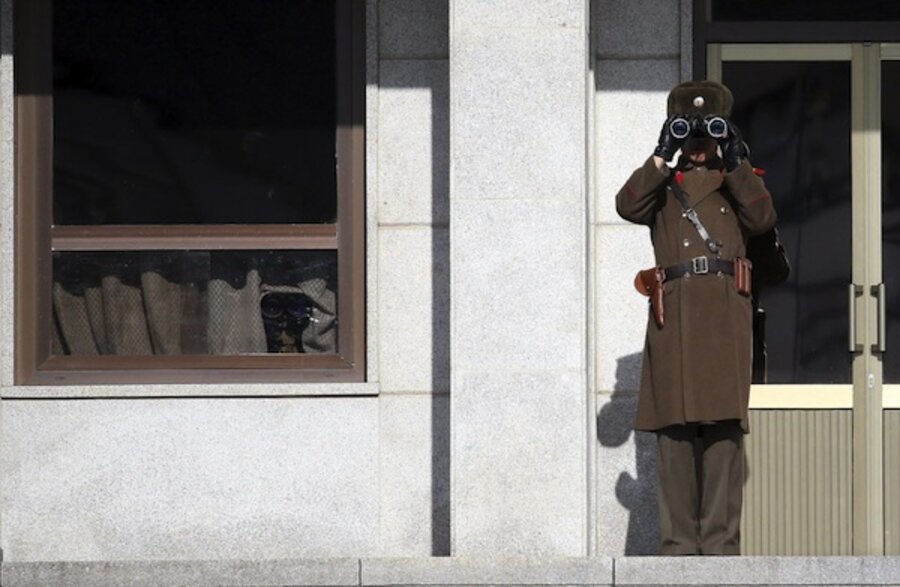US-South Korea joint military exercises – three things you need to know
Loading...
| Seoul, South Korea
Later this month, the US and South Korea will stage annual military exercises around the Korean peninsula. Last year's war games led to months of high tensions as North Korea vociferously objected to joint drills being held near its territory. Its strongly-worded threats in 2013 to the US and South Korea raised fears of a potential conflict, but the drills passed off without incident.
This year could follow the same pattern: North Korea threatened Thursday to cancel planned reunions of war-divided families, one day after the two Koreas reached an agreement on the first such reunions in four years. It accused the US of flying nuclear-capable B-52 bombers near the Korean Peninsula.
North Korea's outbursts notwithstanding, preparations for the annual Key Resolve and Foal Eagle military exercises had been taking place in a more subdued atmosphere amid signs of improved inter-Korean ties. Wednesday's announcement that families divided by the Korean war would be allowed to meet later this month is one sign of this tentative thaw.
In an effort to keep the situation calm, the US military has scaled down this year's exercises.The number of participating US troops is expected to be lower than in previous years, though no final figures have been announced. Last year around 10,000 US troops joined the Foal Eagle exercises and about 2,100 joined Key Resolve. More than 28,000 US soldiers are stationed in South Korea.
What’s North Korea’s beef with the exercises?
Though the exercises are defensive, North Korea has repeatedly criticized South Korea and the US for holding what North Korea calls a rehearsal for an invasion of its territory. During last year’s exercises, North Korea threatened to launch a preemptive nuclear strike on the US and scrapped the armistice agreement that ended fighting in the Korean War in 1953.
Pyongyang has made similar claims this year. Rodong Sinmun, a state-run newspaper, published a report on Jan. 27 that said, "The US is working hard to kick off large-scale joint military drills this year, too, for the purpose of mounting a pre-emptive nuclear attack upon [North Korea]."
North Korea has also asked for the cancellation of this year’s exercises. In a Jan. 24 press conference, North Korea's UN Ambassador Sin Son Ho said that if the drills went ahead, the situation could “fall out of control and plunge into unimaginable disaster."
While Pyongyang has voiced official concern about the exercises, analysts say large-scale military activity by foreign powers in its neighborhood can hold out a propaganda benefit to the regime. North Korea uses external threats to justify the state’s legitimacy and military-first policies, says Kim Yong-hyun at Dongguk University in Seoul. “The exercises are used by North Korea to consolidate domestic support, by highlighting the external threats the country faces,” says Prof. Kim.
Is there a real risk of conflict?
The exercises often create anxiety that war could break out at any time, that a miscue by forces on either side of the Korean divide could provoke an overreaction. Although the exercises "are defensive in nature, if something takes place such as a retaliation from the North Korean military even by accident, the exercises could lead to military clashes,” says Paik Hak-soon, a researcher at the Sejong Institute just outside Seoul.
The 2010 bombardment of Yeonpyeong Island occurred during South Korean military exercises that the North had previously asked Seoul to cancel. North Korea claimed that South Korean forces were firing into their waters and returned fire, sparking an artillery exchange in which four South Koreans died.
While the possibility of conflict cannot be ruled out, analysts point to signs that the risk is lower this year compared to 2013. “There are interesting signs – on both sides – that this year's exercises will not be anywhere near as bad as last year's,” says University of California San Diego professor Stephan Haggard.
One of those signs is the US decision to scale down the military hardware used in this year’s exercises, excluding aircraft carriers or strategic bombers capable of carrying a nuclear payload. Last year, F-22 Raptors, B-2 stealth bombers, and B-52s were used in the drills. The B-2s are capable of carrying nuclear weapons.
“Hopefully Pyongyang takes this as a sign and refrains from provocations that could lead to escalation and potential miscalculations,” says Duyeon Kim, Senior Fellow for Non-Proliferation and East Asia at the Center for Arms Control and Non-Proliferation in Washington.
Prof. Haggard described the use of such heavy-duty weaponry last year as “counterproductive”, arguing, “It is not clear that a larger force presence adds much value to a deterrent that is already stable.”
Could the exercises scuttle inter-Korean detente?
If they go ahead, the inter-Korean family reunions this month would be the first since 2010. The reunions haven’t been held since then due to frosty inter-Korean relations and a sensitive power transition in the North's ruling Kim dynasty.
The reunions are scheduled to be held from Feb. 20-25, around the time of the Foal Eagle exercises. This raises doubts over the timing and the risk that North Korea could pull the plug.
But Columbia University professor Charles Armstrong argues that friction over US-South Korean war games would probably not in itself undo improving inter-Korean relations. “Calls for improvement in North-South relations appear to be genuine, and although North Korea would prefer the exercises to be cancelled altogether, a generally less provocative environment will be conducive to continued North-South rapprochement,” says Prof. Armstrong.
But sustained improvement in inter-Korean relations is still in doubt, as South and North don’t see eye-to-eye on such issues as the resumption of tourism to North Korea's Mt. Keumgang resort. Moreover, the Park Geun-hye administration in Seoul continues to insist that North Korea must take steps toward denuclearization before more substantial inter-Korean dialogue can take place.








